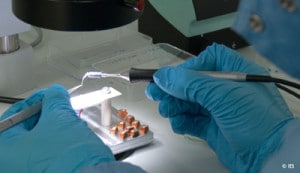Objects of tomorrow
On April 9,the Institute of Electronics and Systems (IES) opened its doors. This was an opportunity for the general public to discover the smart objects that herald the world of tomorrow.
 It has dethroned the fairy of electricity: electronics are at the heart of our societies. Physicists, doctors, urban planners, and even public administrators—no one can do without its applications anymore. Electronics? “The discipline that transforms the physical world into usable information” says Alain Foucaran, director of the IES.
It has dethroned the fairy of electricity: electronics are at the heart of our societies. Physicists, doctors, urban planners, and even public administrators—no one can do without its applications anymore. Electronics? “The discipline that transforms the physical world into usable information” says Alain Foucaran, director of the IES.
Immersion in the electronics of the future
On the Saint Priest campus in Montpellier, the brand new Center for Research Information Science and Technology is home to 220 IES employees. On April 9, it opened its doors for an immersion into the electronics of the future. On the agenda: lasers and Wi-Fi of the future, sensors and nanosatellites, and the energies of tomorrow. But also less spectacular innovations that are at the heart of the smart city. "Water, energy, security, health, the environment... these are all challenges that electronic applications can help us meet in our modern cities. "
Another major challenge is information processing. Alain Foucaran paints a striking picture. "In 2003, humanity finished scanning all the documents produced throughout its history. An enormous mass of information... the equivalent of which was generated in 2011 alone. Today, it takes only 48 hours to produce the same amount of data."
In 2017, 80 billion "communicating objects" will populate the planet. At IES, we are working to miniaturize them and make them more reliable. But also to make them autonomous. This is the ultimate challenge: providing the necessary energy to these discreet and omnipresent servants.
Environment: the sensors that protect us
Identifying pollutants at a glance: that's what lasers designed by the Nanomir group at IES can do. By adjusting their wavelength, these infrared lasers can identify the gaseous species present in the air. The applications? They are numerous, explains Aurore Vicet. "Monitoring greenhouse gas emissions, urban air quality, detecting pollutants inside buildings or vehicles... Today, these environmental issues are crucial, and they represent a rapidly expanding market." Agronomy is also interested: by assessing the amount of ethylene emitted by fruit, IES sensors can help control ripening in situ, without the use of chemicals.
Health: when your joints talk to your doctor
They are equipped with a "SIM card" similar to the one in your cell phone. These new-generation surgical prostheses contain all the relevant data: type of implant, date of surgery, and information on any deformities. This allows your doctor to monitor the condition of your prosthesis in vivo. "The traceability provided by this device also offers a real solution to a public health issue," explains Stéphane Nodi, an orthopedic surgeon: what happens to implants once they have been fitted? How do the various models perform over time? We will finally have a comprehensive view of these issues." Developed by the M2A (Materials, Micro-sensors, and Acoustics) group and the company Bonetag, the system is currently available for hip and knee prostheses. It will subsequently be available for all joints.
Energy: electricity without borders
Every storm reminds us that in France, burying power lines is a priority. Safety, aesthetics, the environment: there are countless arguments for reducing overhead networks. "It's also about transporting energy over very long distances, from one country to another, or providing offshore connections to wind farms at sea," explains Serge Agnel, from the "Energy and Materials" Group. This team now provides cable manufacturers and network operators with a revolutionary technique for testing the reliability of buried or submerged cables. It's a world first for a huge international market, at a time when energy needs are exploding worldwide. The team is currently working on the insulation for the high-voltage direct current networks connecting France and Spain. The next step: the connection with Italy.